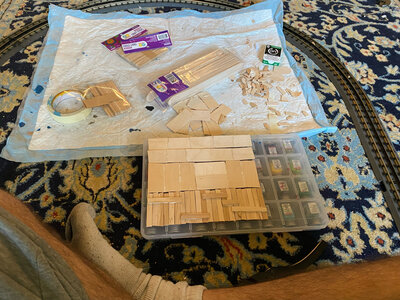All you would need is two trucks, thin pieces of wood, for the chassis and body supports, like lollipop sticks, or stirrers from a coffee shop, bit of thin or very brittle plastic, for the body itself, and some glue
Yes. You are right. At Wal mart they actually sell little baggies of wood sticks of various sizes, including "popsicle" sticks. They are really cheap around $1 for a bag of like 50 for the basic popsicle sticks, and they have other shapes for a little more money.
i would cut them in to 1 inch lengths. They have an elmers art paste that could be used but I learned it's $10 for 2oz. That is a shame cuz I would prefer to own a little cylinder of that and its consistency would be easier to work with. Cheap generic elmers glue should do and that is $1.25. It is sufficient for this application, enough to bond but weak enough to disintegrate with a major impact.
I put it all together, adhere to trucks so it can roll on straight lengths of track like a car. I could buy new ala carte trucks or even source them from some of my old, shitty rolling stock. Several of these cars will be coupled together using some sort of implements. I will paint them various colors with my collection of acrylic and enamel paints, including designs you see on box cars. I will use my supply of used batteries and empty testor's bottles to secure into the cars as well for weight. I already have a habit of using empty testors bottles and used batteries for weight and cargo in hoppers, gondolas and reefers anyway. Aluminum foil may or may not be a thing to include in the construction, it is a little too thin to be prototypical scale thickness of the metal used in train car construction but it sure does crumple on impact. It is important not to make the construction of the cars TOO sturdy however. Any aluminum would need to be used sparingly and in small, separate sheets to allow prototypical disintegration rather than a simple ball of crush. In real world crashes, things come apart in multiple places.
I will place the train 150 to 200 inches downtrack of an LRRC locomotive, attached to another locomotive at the front of it. I accelerate the locomotive to where it reaches a speed of 45 and 50 inches per second. Scheduled to take a turnout, the operator "forgets" to activate the switch, sending the train barreling toward "another parked train" up ahead. When it plows into the train, a massive crush ensues with a hideous sound, the wooden train lurches forward and pops off the track in a fashion that is natural in a train crash, being ripped from the locomotive it belongs to, with bits of "splintered" wood, twisted metal siding and detached wheel trucks flying everywhere. The collision devastates the wooden train on video, without posing much of a threat to the solid LRRC Century Celebration locomotive.
I shall attend Wal Mart at once.
The project commences in a few stages as the walls of wood need to dry before being erected into cars. It takes several hours to complete.
For the record, 45 inches per second is a speed of 123 scale miles per hour. With comparitively thin aluminum siding, and wood/paste construction, the end result will be a mess of twisted metal that approximates a real-world crash where the locomotive is virtually intact but what it hits is crushed. The first crash video I provided occurred at a speed of 40 inches per second and it was pretty cool so no doubt 45 would be sufficient for absolute madness.



